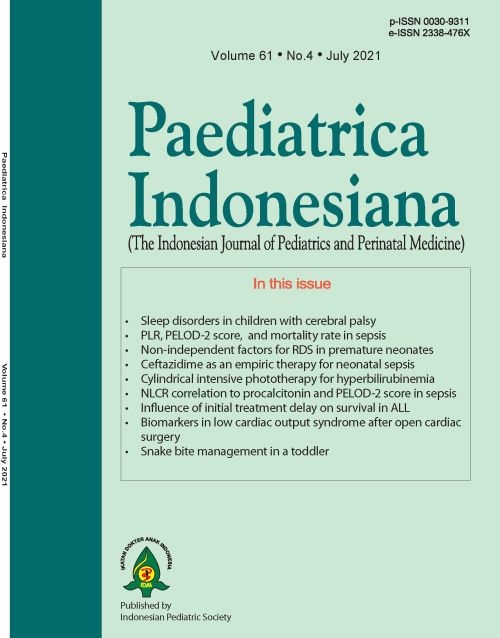Ceftazidime as an empiric therapy for neonatal sepsis
Abstract
Background Sepsis is still the leading cause of death in neonates in developing countries. Proper administration of antibiotics is important for managing neonatal sepsis. The microorganisms that cause neonatal sepsis, as well as their sensitivity patterns, change over time and differ from one place to another. Since 2001, ceftazidime has been used as an empirical antibiotic for managing neonatal sepsis at Dr. Mohammad Hoesin Hospital, Palembang, South Sumatera, but its effectiveness is questionable.
Objective To evaluate the effectiveness of ceftazidime as an empiric therapy for neonatal sepsis.
Methods This study was pre-experimental, for one group, pre- and post-test, was conducted in 49 neonates with neonatal sepsis in the Neonatal Ward at Dr. Mohammad Hoesin Hospital, Palembang, South Sumatera, from April to September 2019. The effectiveness of ceftazidime was determined based on clinical and laboratory improvements 72 hours after ceftazidime administration.
Results Of 49 neonates, 28 experienced clinical and laboratory improvement, while 21 experienced improvement in only one parameter, either clinical or laboratory. Gram positive bacteria were found in 22/49 subjects.
Conclusion There is a significant difference on white blood cell count and CRP level between before and after ceftazidime administration but overall ceftazidime is no longer effective as empiric antibiotic therapy in neonatal sepsis.
References
2. Depani SJ, Ladhani S, Heath PT, Lamagni TL, Johnson AP, Peabody RG, et al. The contribution of infections to neonatal death in England and Wales. Pediatr Infect Dis J. 2011;30:345-7. DOI: 10.1097/INF.0b013e3182102249.
3. Imran M, Tasli JM, Bermawi H. Perbandingan efektivitas kombinasi ampisilin dan gentamisin dengan seftazidim pada pengobatan sepsis neonatorum. Sari Pediatri. 2001;3:92-100. DOI: 10.14238/sp3.2.2001.92-100.
4. Indra RM, Tasli JM, Bermawi H. Perbandingan efektivitas sefepim dan seftazidim dalam pengobatan sepsis neonatorum. Sari Pediatri. 2007;9:213-9. DOI: 10.14238/sp9.3.2007.213-9.
5. Mohsen L, Ramy M, Saied D, Akmal D, Salama N, Haleim MM, et al. Emerging antimicrobial resistence in early and late-onset neonatal sepsis. Antimicrob Resist Infect Control. 2017;6:63. DOI: 10.1186/s13756-017-0225-9.
6. Murthy S, Godinho MA, Guddattu V, Lewis S, Nair NS. Risk factors of neonatal sepsis in India: a systematic review and meta-analysis. PLoS One. 2019;14:e0215683. DOI: 10.1371/journal.pone.0215683.
7. Mehar V, Agarwal S, Singh R, Agarwal A, Agrawal N, Majethia A. Relationship between gestasional age and mode of delivery with neonatal septicemia. Int J Contemp Pediatr. 2016;3:891-5. DOI: 10.18203/2349-3291.ijcp20162361.
8. Jatsho J, Nishizawa Y, Pelzom D, Sharma R. Clinical and bacterilogical profile of neonatal sepsis: a prospective hospital-based study. Int J Pediatr. 2020;2020:1835945. DOI: 10.1155/2020/1835945.
9. Hematyar M, Najibpour R, Bayesh S, Hojjat A, Farshad A. Assessing the role of clinical manifestations and laboratory findings in neonatal sepsis. Arch Pediatr Infect Dis. 2017;5:e29985. DOI: 10.5812/pedinfect.29985.
10. Anderson LB, Gonik B. Perinatal infections. In: Martin JR, Fanaroff AA, Walsh CM, editors. Neonatal perinatal medicine disease of the fetus and infant. 9th ed. Philadelphia: Elsevier; 2011. p. 399-418.
11. Ferrieri P, Wallen DL. Neonatal bacterial sepsis. In: Gleason AC, Devaskar US, editors. Avery’s disease of the newborn. 9th ed. Philadelphia: Elsevier; 2012. p. 538-50.
12. Thermiany AS, Retayasa W, Kardana M, Lila IN. Diagnostic accuracy of septic markers for neonatal sepsis. Paediatr Indones. 2008;48:299-305. DOI: 10.14238/pi48.5.2008.299-305.
13. Fattah MA, Alaskar SA, Alkhamis RI, Othman F, Karar T. The association between neonatal sepsis and C-reactive protein: a cross-sectional study at tertiary care hospital. Int J Med Res Health Sci. 2019;8:54-60.
14. Kafle R, Yadav J, Gupta BK, Gupta BK. Role of micro esr in the evaluation of neonatal sepsis. J Univers Coll Med Sci. 2019;7:25-9. DOI: 10.3126/jucms.v7i2.27131.
15. West BA, Tabansi PN, Ugwu RO, Eneh AU. The predictive value of micro-erythrocyte sedimentation rate in neonatal sepsis in a low resource country. Pediatr Therapeut. 2012;S2:1-8. DOI: 10.4172/2161-0665.S2-002.
16. Darnifayanti, Tjipta GD, Rusdidjas, Lubis BM. Immature-to-total neutrophil ratio as an early diagnostic tool of bacterial neonatal sepsis. Paediatr Indones. 2015;55:153-7. DOI: 10.14238/pi55.3.2015.153-7.
17. Guo J, Luo Y, Wu Y, Lai W, Mu X. Clinical characteristic and pathogen spectrum of neonatal sepsis in guangzhou city from june 2011 to june 2017. Med Sci Monit. 2019; 25: 2296-304. DOI: 10.12659/MSM.912375.
18. Prashanth SN, Rashmi N, Patil S. 3 days vs 7 days course of intravenous antibiotics for probable neonatal sepsis. Int J Pediatr Res. 2017; 4: 149-54. DOI:10.17511/ijpr.2017.02.11.
19. Oeser C, Lutsar I, Metsvaht T, Turner MA, Heath PT, Sharland M. Clinical trials in neonatal sepsis. J Antimicrob Chemother. 2013; 68: 2733-45. DOI: 10.1093/jac/dkt297.
20. Sivanandan S, Soraisham AS, Swarnam K. Choice and duration of antimicrobial therapy for neonatal sepsis and meningitis. Int J Pediatr. 2011; 11: 1-12. DOI: 10.1155/2011/712150.
21. Thapa S, Sapkota LB. Changing trend of neonatal septicemia and antibiotic susceptibility pattern of isolates in nepal. Int J Pediatr. 2019; 19: 1-5. DOI: 10.1155/2019/3784529.
Copyright (c) 2021 Indrayady Indrayady, Afifa Ramadanti, Yulia Iriani, Herka Pratama Putra

This work is licensed under a Creative Commons Attribution-NonCommercial-ShareAlike 4.0 International License.
Authors who publish with this journal agree to the following terms:
Authors retain copyright and grant the journal right of first publication with the work simultaneously licensed under a Creative Commons Attribution License that allows others to share the work with an acknowledgement of the work's authorship and initial publication in this journal.
Authors are able to enter into separate, additional contractual arrangements for the non-exclusive distribution of the journal's published version of the work (e.g., post it to an institutional repository or publish it in a book), with an acknowledgement of its initial publication in this journal.
Accepted 2021-08-16
Published 2021-08-16













